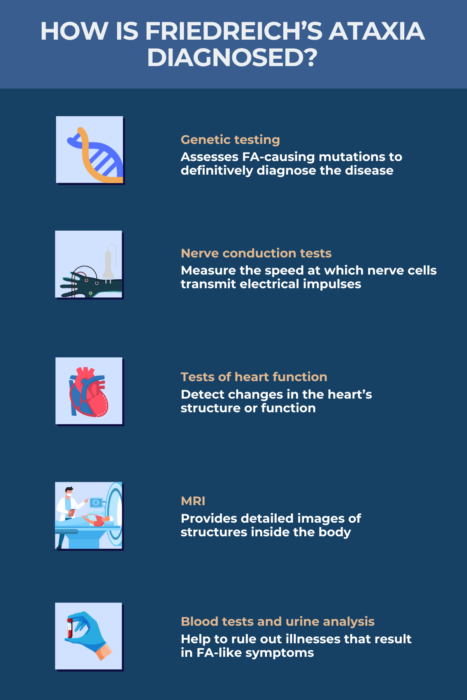Diagnosis of Friedreich’s ataxia
A diagnosis of Friedreich’s ataxia (FA) can be reached by carefully reviewing a person’s symptoms, medical history, and family history of neuromuscular disorders, followed by confirmation with certain tests.
A doctor will first perform a thorough physical and neurological examination, and look for problems like difficulty balancing and impaired reflexes, which are indicative of the type of nerve damage that occurs in FA.
In most cases, a conclusive Friedreich’s ataxia diagnosis is reached through genetic testing. Additional specialized tests, including those of nerve-muscle function, heart function, brain and spinal cord imaging, and blood tests, may also assist in identifying FA.

Physical examination
The first step in diagnosing FA is a physical examination, where a doctor will look for symptoms consistent with FA. Hallmark features of the disease that are usually evident early on include problems with balance and gait unsteadiness, or ataxia.
Other signs of FA a doctor may look for include:
- loss of reflexes, especially the knee-jerk reflex
- loss of sensation
- skeletal problems, including abnormal spine curvature (scoliosis) or foot deformities
- involuntary eye movements.
When considering FA, a doctor might also think about a patient’s age. The onset of FA typically occurs between the ages of 5-15, but can arise at any age. A family history of similar symptoms might also be indicative of FA or another genetic disease.
Genetic testing
Once FA is suspected, genetic testing can be employed to definitively diagnose the disease and rule out other neuromuscular conditions.
FA is caused by mutations in the FXN gene. For more than 95% of patients, these mutations involve the excessive repetition of a particular trio of DNA building blocks, or nucleotides, called GAA. For FA symptoms to manifest, both copies of the FXN gene — one from each parent — must be mutated. More rarely, patients have a GAA repeat expansion in one copy of the gene and another type of mutation, called a point mutation, in the other.
Genetic testing for Friedreich’s ataxia can be performed with a small blood or saliva sample using a range of laboratory techniques. Most commonly, scientists will screen the DNA from these samples to look for excessive GAA repeats in both copies of the gene. Where appropriate, they may also look for point mutations, or for genetic deletions if no disease-causing mutations are identified.
This test is highly reliable for confirming or excluding an FA diagnosis in nearly all cases. If mutations in both genes are identified, FA can be confirmed. If a person has Friedreich’s ataxia symptoms, but no mutations in FXN, it’s possible they have another neuromuscular disease with a different cause.
The test is also able to identify if a person has only one mutated copy and one normal copy of FXN. Such individuals are said to be carriers of the disease, because they will not develop FA themselves, but may pass disease-causing mutations to their children. Two people who are both carriers have a 25% chance of having a child with FA.
Nerve conduction tests
A nerve conduction velocity (NCV) test, which measures the speed at which nerve cells transmit electrical signals, can be used to assess signs of nerve cell damage indicative of FA. In the test, a small electrical impulse is delivered to the skin over a nerve and electrodes placed on different locations above that nerve record the electrical response to the stimulation.
In FA, the signaling speed of the sensory nerves, those that transmit information to the brain about sensory inputs, are found to be severely slowed or absent. Motor conduction velocities, or signaling speeds in the nerves that innervate muscles to coordinate movement, may be mildly impaired or normal.
This can help to distinguish FA from other neuromuscular conditions where motor nerve conduction is more markedly impaired, but still cannot alone be used to diagnose the disease.
Electromyogram
Another test that may be performed alongside NCV is called an electromyogram, or EMG, which evaluates a muscle’s response to stimulation from the motor nerve cells that control it. It can further help detect issues with muscles, the nerves the control them, or the way the two types of cells communicate.
In the test, a needle-like electrode is inserted directly into a muscle and used to measure its electrical response during a muscle contraction. In FA, the muscles may show an abnormal response during a contraction.
Tests of heart function
FA patients commonly experience heart abnormalities. The most common is hypertrophic cardiomyopathy, where the heart muscles become enlarged and weakened. This makes it harder for the heart to properly fill with blood and pump blood out to the body.
A few different tests can be used to look for changes in the heart’s structure or function that are indicative of Friedreich’s ataxia heart disease.
Electrocardiogram (ECG)
An electrocardiogram, or ECG, measures the heart’s electrical activity and provides a graphic representation of its beat pattern.
Small electrodes are attached to the skin over the heart. These electrodes will record the heart’s electrical patterns and generate a pattern of wavy, or spiky, lines, that indicate its rhythms. A doctor will examine these images to look for any abnormalities indicative of FA or another condition.
A common finding in Friedreich’s ataxia ECG is called a T-wave repolarization abnormality, an electrical change wherein the heart’s ventricles have trouble resetting in preparation for the next heartbeat. Other types of heartbeat changes that could be captured with an ECG include a faster than normal heart rate (tachycardia), abnormally rapid or irregular heartbeat (heart palpitations), or a slowed heart rate with accompanying electrical changes.
An ECG may be performed at the doctor’s office while a patient is lying down. In some cases, if longer monitoring is necessary, patients may be equipped with a portable Holter Monitor, which can measure the heart’s electrical activity continuously for a day or two while a person goes about their daily life.
Echocardiogram and cardiac MRI
Also known as a heart ultrasound, an echocardiogram uses sound waves to produce an image of the heart while a patient is lying down. Doctors can use these images to assess heart function and blood flow through the heart, thickness of the heart muscle, and the size of the heart’s chambers.
In particular, this test can detect signs of hypertrophic cardiomyopathy, including an enlargement of the heart’s muscles (hypertrophy) and a thickening of the left ventricle, responsible for pumping blood out to the rest of the body. This test may be used when making an initial assessment of cardiac involvement in FA, and to monitor the progression of heart disease or responses to Friedreich’s ataxia treatment over time.
More recently, cardiac MRI has also been used to look at the heart and assess for cardiomyopathy or other heart diseases. Instead of sound waves, MRI uses powerful magnetic fields and radio waves to create a detailed image of the heart.
Magnetic resonance imaging
MRI imaging can be used to scan the brain and spinal cord for signs of deterioration. This test can capture tissue atrophy, or shrinkage, in the brain and spinal cord, which is common in FA. In particular, the neck (cervical) region of the spinal cord is usually smaller than normal in people living with Friedreich’s ataxia due to tissue atrophy.
The cerebellum, a part of the brain that coordinates voluntary movements, may also be slightly smaller than normal, but atrophy in this region is not as pronounced as what is observed in other types of hereditary ataxia that may have similar symptoms. This can help distinguish FA from those conditions, such as spinocerebellar ataxias.
MRI images are also useful for ruling out other neurological conditions that might cause related symptoms. For example, tumors or blood clots in the brain can cause ataxia-like symptoms and are usually visible on an MRI.
Blood tests and urine analysis
Blood and urine tests may rule out other illnesses that can cause similar symptoms to FA, including:
- infections
- nutritional deficiencies, particularly, genetic vitamin E deficiencies can lead to progressive ataxia with a very similar clinical picture as FA.
These tests can also detect chemical imbalances that are commonly associated with diseases other than FA, and measure biomarkers that are suggestive of FA.
Blood and urine tests might also be used to check a person’s blood sugar to determine if they have diabetes, another symptom of FA.
Friedreich’s Ataxia News is strictly a news and information website about the disease. It does not provide medical advice, diagnosis, or treatment. This content is not intended to be a substitute for professional medical advice, diagnosis, or treatment. Always seek the advice of your physician or other qualified health provider with any questions you may have regarding a medical condition. Never disregard professional medical advice or delay in seeking it because of something you have read on this website.
Recent Posts
Related articles

 Fact-checked by
Fact-checked by 



